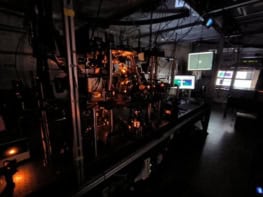
Researchers in the US are the first to use single fluorescent dye molecules to probe the local electromagnetic fields inside nanoscale “hotspots” on metal surfaces. The imaging technique can identify structures as small as just 15 nm across with a resolution of less than 2 nm – which is much smaller than conventional optical microscopes can achieve.
When light is shone onto nanostructured metallic surfaces, such as those made from gold or silver, hotspots of concentrated light can appear where the electromagnetic field is very intense. Scientists have known about this surface enhancement for over 30 years and have used the effect in techniques like surface-enhanced Raman spectroscopy to image very small samples of molecules and even single molecules. Despite the success of the method, however, scientists struggled to measure the size of these hotspots and how they enhanced spectroscopic measurements.
There are two challenges when it comes to probing the hotspots. First, a hotspot is randomly located on the surface of a metal and is therefore very difficult to find. Second, a hotspot is smaller than the wavelength of visible light and so cannot be detected by an ordinary optical microscope, which normally cannot focus light to a spot smaller than half the wavelength of light – something known as the diffraction limit. More sophisticated imaging techniques, like near-field scanning optical microscopy (NSOM) and electron energy loss spectroscopy (EELS) are not up to the job either because they are limited by the size of their probes.
Ideal probes
Now, Xiang Zhang and colleagues at the University of California at Berkeley have overcome these problems by using single molecules, which the team believes are ideal probes for getting inside hotspots because they are smaller than a nanometre across.
The scientists begin by putting a sample – a rough metal film or metal nanoparticle clusters deposited on a quartz surface – in a fluorescent dye solution and allow the dye molecules to randomly adsorb onto the surface of the sample. The molecules disperse naturally in this way via Brownian motion. When the sample is then illuminated with a laser beam, many hotspots appear on the surface as expected.
By adjusting the concentration of the dye, the researchers ensure that, on average, only one dye molecule arrives at a hotspot at a time. When a single dye molecule binds to a hotspot, its fluorescence is greatly increased and it appears as a bright spot whose intensity can be measured to calculate the level of light enhancement. In this way, the team can obtain an image of the fluorescent enhancement profile of a single hotspot as small as 15 nm across with an accuracy of 1–2 nm. The team found that the light’s field strength decays exponentially from the hotspot peak. This result had been predicted by simulations before but never directly measured in an experiment until now.
‘Perfect tool’
“Our technique could be used to study light–matter interactions in a variety of nanostructures and materials, including nanoparticles, films and wires,” team member Hu Cang said. “It is the perfect tool to help design nano-optics devices and materials to control the flow of light at the nanoscale.”
He added that the hotspots could also be used to boost the sensitivity of biosensors, for example in single-molecule DNA sequencing by focusing the light to a single molecule and substantially suppressing the background noise. “They might also help to improve the efficiency of solar-energy devices by concentrating light to the nanometre-sized active sites in these devices where light is converted into chemical energy or electricity.”
The team says that it would now like to correlate its measurements with the morphology of the metal film and nanoparticle clusters measured using electron microscopes. “With the help of computer simulations, we hope to figure out how these hotspots defy the diffraction limit of light and concentrate light energy into such a small space.
Looking for a lower limit
And last but not least, no theory has yet predicted how small these hotspots can be so the researchers are busy examining other materials like silicon and titanium oxide in the hope of finding even smaller ones.
“Single-molecule imaging – or super-resolution fluorescence microscopy – was named ‘method of the year’ in 2008 by the journal Nature Methods. It has so far been used to primarily image biological samples, but we have shown that it can easily and successfully be extended to other areas,” added Cang.
The results are published in Nature 469 385.



